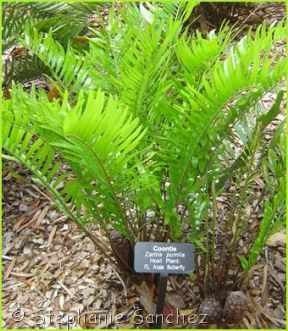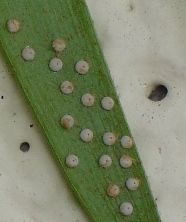I have been butterfly gardening for years and it is very hard to attract the Atala Butterfly. The Atala Butterfly (Eumaeus atala) is a small but beautiful butterfly that was almost extinct but is making a comeback. Its coloring is amazing with black wings, on orange red abdomen and fluorescent blue spots. Common names for the Atala butterfly are the Atala, Atala hairstreak, and Coontie Hairstreak. The Atala butterfly can be found in Southeastern Florida, the Bahamas, and Cuba. The Atala butterfly has been reported from Dade County north up to Martin County, Florida.
Like all butterflies, atalas need a specific host plant on which their larvae feed. The host plant for atalas is a coontie, a relative of the sago palm whose primary natural habitat is pine flatwood. When I first started to garden for butterflies I planted a few (1-2) Coontie plants thinking that would be enough to attract the butterfly. I was wrong and later found out that you needed many (20) coontie plants to attract the atala butterfly. Fairchild Garden does a beautiful job attracting the atala but they have so many coonties planted. When I visit Fairchild’s Butterfly Garden you can see the atala larvae on the coontie plants.
 |  |
Coontie plants contain a natural toxin, which atala larvae accumulate in their bodies and use to repel birds. Without coontie, adult atalas have no place to lay eggs and no eggs means no new generations. Wild coonties’ demise began with starch: Long before Europeans arrived in Florida, Native Americans used coontie as a source of starch. Coontie, in fact, is a Seminole word that means “bread” or “white root” because the roots can be made into flour. Settlers continued the practice on an industrial level. In the early 1900s, several commercial factories in South Florida processed coontie roots for the manufacture of arrowroot biscuits. Coontie plants started disappearing throughout Florida, and so did the atala butterfly. By 1965, federal and state authorities thought the atala was extinct. The atala is making a comeback because people are using coontie in landscaping and because people are becoming interested in butterflies.
During this year I have noticed several atalas in my garden. The first time I saw one I thought I had to be mistaken. I only have one coontie plant so I thought there was no way I would have the atala in my yard, but I do. In fact I have several atalas in the back of the yard by several flowering palm trees and the logustrum tree. Adult butterflies take flower nectar and sometimes roost in trees. This is why I think they were in the back of the yard around the flowers of the palms and were roosting on the logustrum tree. I also have several other Florida natives that are nectar sources for the Atala, i.e. spanish needle, butterfly bush, lantana, pink powderpuff, etc. I am so happy to have this little visitor in my yard.



